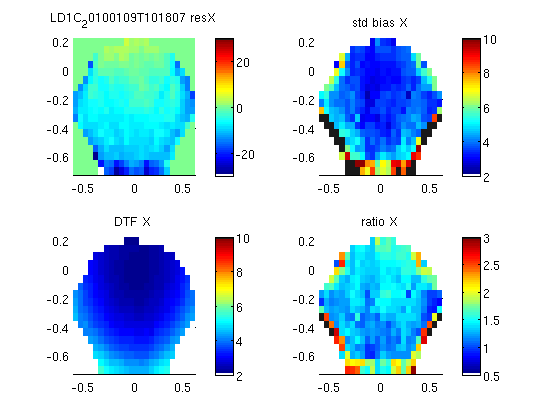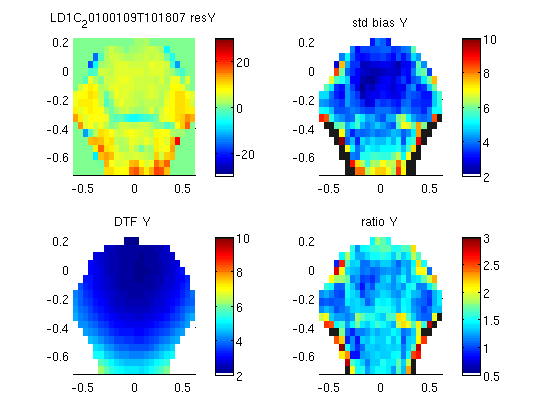Earlier, a note on this blog showed there was some hope for improvement when applying a correcting map in the (swath abscissa, incidence angle) reference frame.
This clearly was a proxy for the cosdir reference frame. Since then, my CESBIO friends have provided the magic wand stick to compute the cosdir Xi and Eta.
Meanwhile, Joe Tenerelli in the OS team has gone much further and proposed an empirical correcting map which he termed OTT (Ocean Target Transformation). Hence the title of this note.
Here are the results for an orbit over the american sector, that was initially devoted to the decimation study. The next graph shows the coverage when keeping only the DGG where L2 convergence was obtained and Soil Moisture was retrieved.
Then the TB residuals (about 500 000 of them) where sorted into 0.05 x 0.05 cells in the cosdir frame.
Here are sequentially for TX and TY the plots of
(1) top left : the mean residual itself (Kelvin) in each cell ;
(2) top right : the standard deviation of the residuals
(3) bottom left : the radiometric uncertainty from L1C files
(4) bottom right : the ratio of (2) to (3)
Comments :
-
the std is very much smaller than the typical absolute value of the residuals ;
-
the std becomes if not close, at least not too far away from the ideal spread expected when considering the radiometric uncertainty. Over the cosdir frame, the mean value of the (4) ratio is very close to 1.5, and since this figure includes border cases it will substantially decrease when border cells are removed.
In other words there seems to be here a possibility of substantial improvement. Of course one has to check what happens over other land zones, but the large coverage over the americas is encouraging.
Same as in the ocean case, this approach has a major weakness, that is it is model dependant. Actually, for the land case, I only used the L2 model as a way to provide some kind of smooth adjustment removing the mean overall bias, without caring at all for the actual retrieved values.
The aim of this exercise does not consist in proposing to apply this correction map. It aims to give us confidence, because it establishes empirically that a very efficient correction map in the cosdir frame can be found which is largely independent from the scene.
Now the correct method consists in finding this correcting map without refering to any forward model. Progresses have already been made since the LO-test orbit and it is quite sure that residuals from recent L1 editions will be already much smaller. We shall try to keep you posted.



